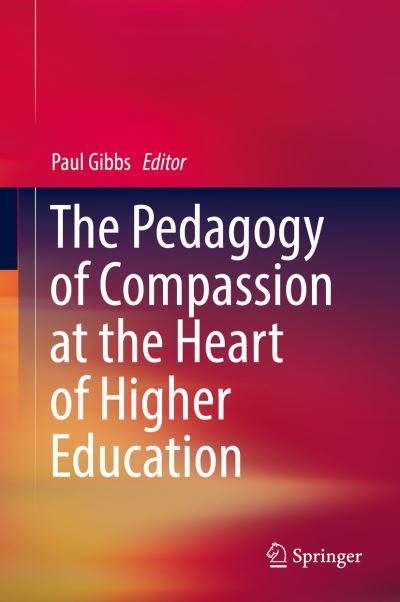Book Review: "The Pedagogy of Compassion at the Heart of Higher Education"
The Pedagogy of Compassion at the Heart of Higher Education
by Paul Gibbs
Reviewed by Dr Juliet Raynsford (Education Studies)
Why did I want to read this book?
Two reasons, really. Firstly, during the lockdowns I have increasingly been thinking about the role of compassion in Higher Education (HE). Especially, although not exclusively, in my teaching practice with undergraduates, but also within my interactions with colleagues. Secondly, this book has a chapter in it written by a colleague of mine, Dr Abdullah Sahin, and I wanted to explore his work in more detail within the context of other writing on compassion and HE pedagogy.
3 key takeaways from this book?
1. Through HE pedagogy critically engaging with the hegemony of Western thought a wider appreciation of what compassion is, in theory and in practice, becomes possible.
2. Thinking about compassion in HE, involves coming back to the core questions that lie at the heart of HE pedagogy and practice: ‘What is the purpose of a university?’ and ‘How can the relationship between HE and the world be configured to increase, rather than decrease, compassion and understanding between the HE sector’s various stakeholders?’
3. HE institutions across the globe are having to come to terms with the atrocities and inequalities dealt by previous social and educational systems. Students and staff, their families, their ancestors, have had their cultures, their faiths, their identities denied, marginalised, and brutalised. To achieve peaceful coexistence, dialogue, understanding and forgiveness, HE institutions must be prepared to be more compassionate, inclusive, innovative, and creative in how they approach pedagogy and institutional practice.

What definitions of compassion does this book explore?
This book spends time exploring the differences between the related concepts of sympathy (feeling sorry for someone), empathy (being able to imagine how someone might feel), and compassion. By the end of the book, I felt a consensus could be identified between different authors’ definitions of compassion, with the following overarching definition emerging:
Compassion is actively responding to a situation where a person or people are in trouble or disadvantaged without expectation of personal gain.
In his opening chapter the book’s editor Paul Gibbs (2017) explores several different well known Western philosophers’ positions on compassion which established several useful analysis frames through which to reflect on compassion. For example, Schopenhauer’s philosophy on compassion is explored, with Gibbs (2017, p.5) suggesting Schopenhauer believed that compassion could only be achieved when individuals ‘transcend their individualistic, egoistical inclinations’. In contrast philosophers like Nietzsche (2008) are discussed and ideas such as ‘to be compassionate is to be weak’ (Sahin, p.129) are debated. As a non-philosopher I found these sections quite challenging, but not inaccessible and essential for engaging with later debates.
What are the features of a compassionate educator? What might compassionate pedagogy in a HE context look like?
Firstly, it must be noted that a theorist many commentators referenced was Martha Nussbaum. ‘Compassion is an evaluative cognitive process’, paraphrases Gibbs, for example, in his analysis of Nussbaum’s work in his opening chapter (2017, P.4). Later, in Chapter 7, Ramrathan (2017, p. 101-112), when discussing the transformation of HE practices in South Africa suggests Nussbaum’s work highlights three principles the compassionate teacher must acknowledge in the classroom:
- There needs to be an understanding and recognition of the suffering of students as serious.
- Compassionate teaching will be grounded in the belief that the sufferer does not deserve to suffer and that the HE environment should not further exacerbate their suffering.
- The practice of the classroom is dedicated to ‘forging identification between the sufferer and those who feel compassion’ with the acknowledgement this may not be everyone in the class.
- Ramrathannn (2017, p.102) based upon the ideas of Nussbaum (1996)
What Ramrathan’s chapter helps highlight is that their university has tried in recent decades to operate forms of ‘structural compassion’ within their HE pedagogy (Ramrathan, 2017, p.102). What comes across strongly from this chapter is that this is a gigantean task, and that, in many ways, a university’s pedagogy cannot address gross social inequalities on its own. However, Ramrathan puts across a strong argument for universities pro-actively responding to students’ feedback on what it means to be respected and treated compassionately within a university context. I was very interested to read of the ’humanizing discourses and practices’ (Ramrathan, 2017, p.111) Ramrathan’s South African university has tried to build into their pedagogical practices which place an emphasis on acknowledging students’ ‘subjectivities and pluralities’ (ibid), and how simply trying to raise greater awareness and understanding of what these are for students both before entering HE and once they have arrived, can have the result of fostering more meaningful dialogue between student peers, tutors, course leaders and senior leaders.
In conclusion, many writers suggest at the heart of compassionate teaching will be a commitment to person-centred pedagogy that seeks to encourage human flourishing. Many examples are given that explore how this will often involve a commitment to fostering pedagogies that nurture civic values and recognising students’ heritages and cultural values. Simply put, when discussing effective pedagogies for promoting a compassionate HE culture, ‘Attentiveness to others suffering’, was discussed many times.
Can compassion be both a moral good and a moral bad?
This book partly explores how different social and economic models can promote forms of compassion which, rather than being altruistic and empathetic, become laden in self-interest, institutional gain, and self-promotion. I found Gibbs’s emphasis in his introduction chapter on the idea that the majority of HE institutions ‘reflect their society’s key values, needs and anxieties, rather than shape them’ (Gibbs, 2017, p.6) a useful idea to return to in later chapters. For example, Gibbs highlights the proliferation of caring services on HE campuses in recent decades, often developed to support student and staff mental health and the increase in general anxiety amongst university populations. However, he also raises the question of whether providing more services is always a compassionate response by institutions, especially if institutions do not actively tackle the causes of anxiety and stress, especially those student and staff feedback suggests may arise from specific institutional structures, policies, and practices.
Many chapters explore how many contemporary HE institution are based upon a consumer model, where humanist and spiritual values are side-lined in preference for a ‘product-driven consumer service business model’ (Gibbs, 2017, p.9). There is plenty of opportunity given within this book to reflect upon the idea that when HE Institutions are governed by neoliberalist economics they develop a tendency to promote qualities like ‘independence and personal achievement, competition, selfishness and the pursuit of profit, status and power’ (Gibbs, 2017, p.9) within their student and staff bodies and this can be seen as ‘diametrically opposed to the qualities associated with compassion’ (Spandler and Stickley, 2011, cited by Gibbs, 2017, p.10). I personally found this area of discussion engaging, and felt it was done in a balanced and constructive way.
The discussions of the dominance of neoliberalist governance and leadership within global HE trends led me to reflecting on what possible futures lie ahead for universities, leading to the formulation of questions such as: Do we want institutions that only function mechanically and financially? Is global homogenisation, based upon neoliberalist economics, a good or bad thing for HE institutions? If global homogenization of HE continues a pace does there need to be reflection on what values and principles shape this homogenisation? For example, could compassion become an active part of the philosophy of HE homogenisation? What would need to change, structurally and from a policy perspective, to make this more possible?

Compassion and Islamic Pedagogy
In Sahin’s chapter (2017, p.127 – 141) on ‘Education as Compassionate Transformation: The ethical heart of Islamic Pedagogy’ Sahin explores the history of Islamic education and contemporary misunderstandings of what Islamic Pedagogy involves and seeks to achieve. Part of Sahin’s argument is that it is essential in contemporary HE that dialogue is enabled between those belonging to diverse cultures, faith traditions and contrasting value systems. It is only through this process, he argues, that peaceful coexistence will ever have a chance. His writing acknowledges the complex challenges facing young Muslim people entering higher education and stresses the need for reflective/holistic educational practices that ‘facilitate the cross-pollination of ideas and experiences’ (Sahin, 2017, p. 136) of different faith traditions as well as secular Western humanist values.
Would I recommend this book?
This is an academic textbook. It was hard to read the chapters consecutively sometimes. However, individual chapters did stand out and I will be rereading these and recommending them in the future.
Juliet Raynsford
Education Studies
April 2022

